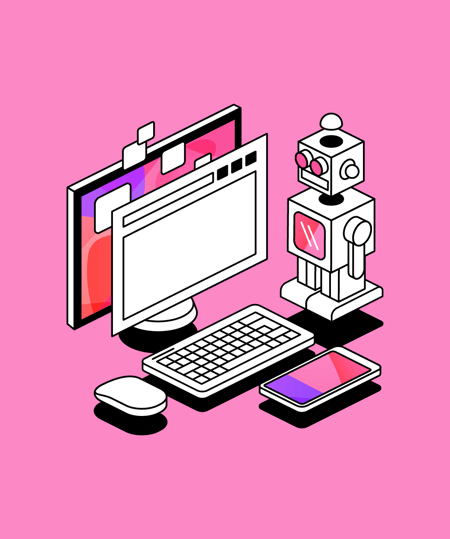AI and learning: a balanced approach to Assistive Technology in Higher Education
We sat down with Dave Casey, Glean’s AI Product Lead, to discuss how we’re introducing AI with care and consideration at Glean as well as exploring how institutions can approach the adoption of AI both thoughtfully and strategically.
 2 min read
2 min read
 Published: 13 Jun 2024
Published: 13 Jun 2024
 Jacob Goodwin
Jacob Goodwin


The ongoing integration of artificial intelligence (AI) into educational tools has sparked both excitement and apprehension among educators.
The vast majority are viewing artificial intelligence (AI) through a lens of opportunity however it remains critically important to maintain a wary eye on advancements to ensure technology augments, rather than replaces the learning process.
In a world increasingly reliant on AI, learners and educators alike need to trust the software they interact with. Therefore, a balanced approach is essential when utilizing AI applications, especially in an education environment.
We recently sat down with Dave Casey, Glean’s AI Product Lead, to discuss how we’re introducing AI with care and consideration at Glean as well as exploring how institutions can approach the adoption of AI both thoughtfully and strategically.
Here’s what he had to say…
The rise of AI: opportunity or obstacle?
When framing the rise of AI at large, Dave emphasized that the education sector has a history of embracing technological advancements to support students; citing examples like captions, grammar checkers, and speech control as evidence of a forward thinking industry.
However, the advent of generative AI, with its broader reach and capabilities, has raised new questions and considerations.
Recent surveys from EDUCAUSE reveal that institutions are actively developing AI strategies, but implementation remains in its early stages.
A significant challenge lies in ensuring that these strategies prioritize student learning experiences and involve students in the decision making process, rather than looking simply to provide productivity hacks or chances to cut corners.
Assessment and personalized learning
Dave highlighted two primary areas where AI will significantly impact education:
Assessment: While concerns about AI assistance affecting the reliability of exams are valid, the focus should shift towards assessing students' understanding and comprehension rather than solely on the final product they create.
This can be achieved by emphasizing the learning process itself, rather than just the outcome and the need to develop critical thinking and evaluation skills for later life.
Personalized learning: AI can offer students personalized support akin to having a dedicated tutor.
This can empower learners to seek help with difficult concepts or questions they might hesitate to ask in a public setting. Institutions must consider the ethical implications of this new form of tutoring and ensure that AI powered tools are used responsibly and transparently.
Striking a balance
As with many things, a balanced, considered approach is the most effective route forward.
Dave suggests a simple guideline for students using AI-enabled tools: treat AI like a classmate, not an infallible entity.
It's essential to acknowledge that AI can make mistakes and that different models have varying capabilities and limitations.
Educators must also educate themselves and their students about the specific tools being used on campus. This includes understanding how they work, their potential biases, and their limitations.
By fostering a culture of informed and responsible AI use, institutions can maximize the benefits of this technology while mitigating any risks.
Looking ahead: a collaborative approach
The integration of AI into education is an ongoing journey that requires a collaborative approach involving educators, administrators, students, and technology providers.
By embracing AI as an assistive tool and prioritizing transparency, ethical use, and student centered learning, institutions can harness its potential to enhance the learning experience for all students.
Additional considerations for institutions
Countless institutions are evaluating how AI will make an impression on campus life, learning and teaching.
Here are a number of considerations you can make to help ensure you strike the right balance:
- Develop clear AI policies: Establish guidelines for the procurement, use, and evaluation of AI tools in the classroom.
- Invest in faculty training: Provide professional development opportunities for educators to learn how to effectively integrate AI into their teaching practices.
- Promote critical thinking: Encourage students to evaluate the information they receive from AI tools and develop their own independent judgment.
- Prioritize transparency: Clearly communicate to students how AI is being used in their courses and what data is being collected.
By approaching AI with a balanced perspective and prioritizing student well-being, institutions can navigate the complexities of this rapidly evolving landscape and ensure that AI serves as a powerful tool for educational advancement.
More from Supporting Students
View All
 5 min read
5 min read
Understanding and supporting students with barriers in higher education
Take a deeper look into students with barriers to learner. Here, we discuss who they are, what challenges they face and what institutions can do to support them.

 3 min read
3 min read
Understanding and supporting time poor students in higher education
Here, we take a deeper dive into who the time poor learners are, and their unique challenges. Explore strategies to support students juggling multiple roles and responsibilities, to create a more inclusive and flexible learning environment.

 3 min read
3 min read
Navigating the AI landscape in education: Helping or hindering student success
AI has transformed what it means to teach and to learn. It is crucial now for higher education leaders to determine how they deploy AI to help, rather than hinder, student success.





